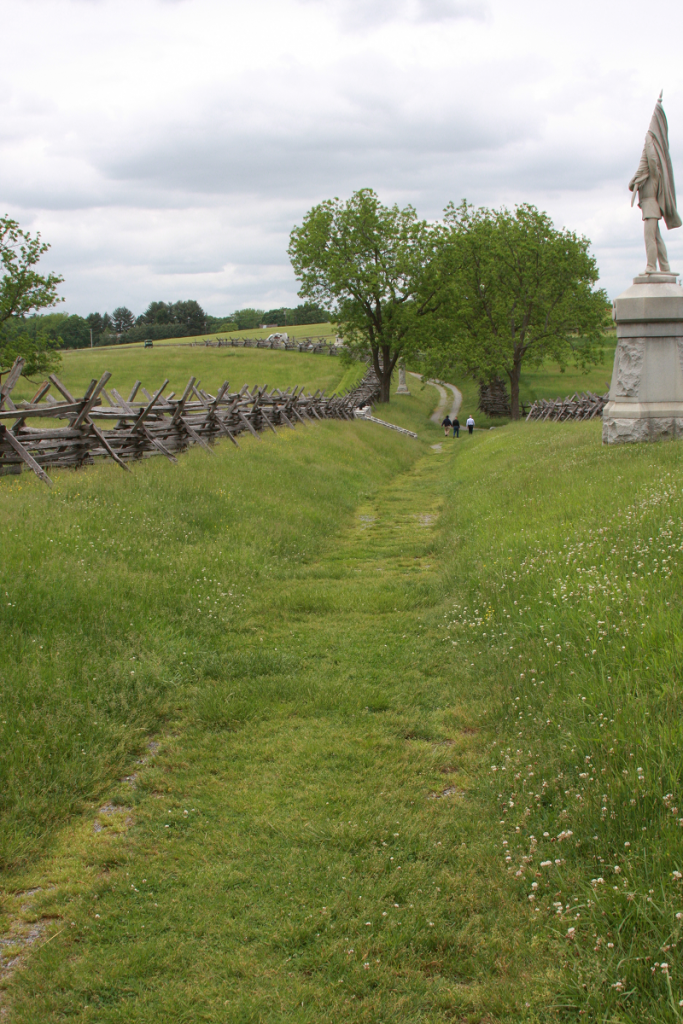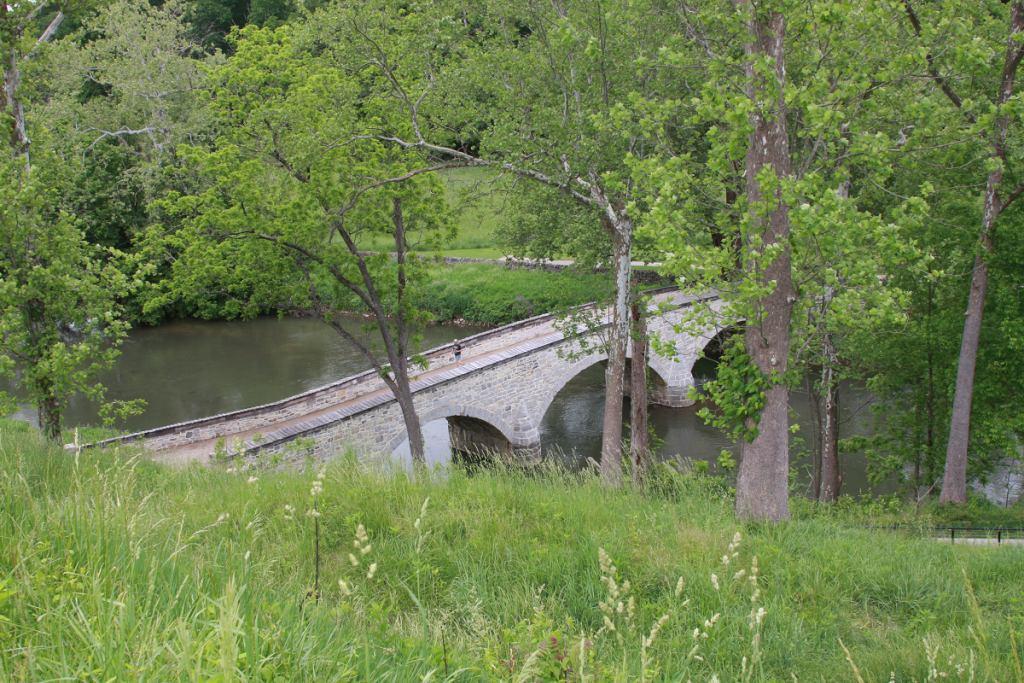May 25, 2022 @ 09:30 EDT
Site Visit #25
One every second!
That statement really struck home for me.
What am I talking about? Looking at the title of this entry, you may have a guess. For those who don’t know what Antietam was, it was an 1862 battle in the U.S. Civil War. It was the bloodiest single day in U.S. history, even up to today. In twelve hours of fighting, around 23,000 soldiers on both sides were killed or wounded.
Much of this carnage happened in the morning, with the battle starting around 5:30 am. As related by the park ranger during his excellent presentation, the casualty rate during that morning was one every second. One casualty EVERY SECOND.
I arrived at the Visitor’s Center for Antietam National Battlefield around 9:30. The current Visitor’s Center is in a temporary building as the permanent center is being thoroughly renovated. For a temporary center, it was quite nice, with lots of space. A gift shop provided the requisite stamps for the Passport book and a few souvenir purchases. Across the hall, a park volunteer explained the driving tour, which follows the order of battle throughout the day.
There was the aforementioned ranger presentation starting at 10:00, as did a 30-minute video in the theater. The video repeated every half-hour, while the ranger presentation was every few hours, so I went with the ranger. Standing near a monument to the New York on some of the highest ground of the battlefield, he explained the movements and clashes from the initial Union assault from the woods to the North (cleverly named the North Woods) into a cornfield (cleverly named…well, you can guess). He described the brutal battles inside the Cornfield where one could hardly see 10 feet away. It changed hands several times until Union reinforcements came out from the East Woods.
The goal was to try and push the Confederates into the West Woods and back them against the Potomac River. But confusion partially brought on by what proved to be a deadly day for generals on both sides, caused the advance to fail.
Joseph Mansfield entered West Point at age 14, graduating in 1822. He served through the Mexican War and rose to the rank of General. But he was an engineer. Apparently a brilliant engineer, who designed nearly 90% of the defensive fortifications around Washington DC. But he wanted a combat role. He got his wish just days before the battle of Antietam, and on the morning of the battle, he was ordered to advance his very green troops from the east into the fray. Less than twenty minutes later, he was shot in the chest, and 24 hours later, he was dead.

Further south, more Union troops came from the east and ran directly into 2000 crack Confederate troops hidden in a sunken road. They repulsed attack after attack by raw Union troops until their ammo ran low and Union troops got their flank. So many southern soldiers ended up dying in the sunken road that it became known by a new name: bloody lane. Photos taken immediately after the battle brought the first true images of death to northern readers.
In the late afternoon, fighting shifted to the south, where Union General Burnside was trying to get across Antietam Creek. There was a narrow bridge that could be crossed, but on the far side up on some bluffs, 500 Confederate troops held off his advance, raining fire on anyone trying to cross the bridge. I often wondered why they just didn’t ford the creek, but now, seeing it in person, I realize that this was a wide and deep creek (I’ve seen rivers that were smaller). Burnside did find a ford a mile downstream, but all of these things caused delays and cost time.
When the southern troops up on the hill ran out of ammunition, Burnside was able to get his troops across (aided by many using the ford). His goal now was to block the southern armies from getting to the Potomac and back to safety in northern Virginia. Doing so might force the surrender of the bulk of the southern army in the east, possibly ending the war.

But we know that didn’t happen. Burnside’s delays crossing Antietam Creek allowed enough time for A.P. Hill’s forces to arrive. These men had marched 17 miles from Harper’s Ferry, running the last few miles, to get into the battle. Their arrival stopped Burnside from cutting off the army. Night was falling, and fighting stopped.
Both sides expected the battle to resume the following day, but General Lee took stock of his troops and decided that his best course was to return to Virginia. The first southern invasion of the north had ended. Lee would return again in ten months, meeting Union troops in Gettysburg, my stop two days from now.
The park has created a driving tour which is marked on their brochures. However, by using a cell phone, one can access much greater detail about each spot on the tour, including a video of a ranger describing the action at that point. As the volunteer at the Visitor’s Center told me, the cell phone tour works great except if you have Verizon as their coverage of the park is poor. I have Verizon. And the video kept cutting in and out. I still got a lot out of it and can watch it all later.
In addition, the park is well marked with informational signs. Some give details of what happened at that point. Others – black with white lettering – describe in great detail what units from what regiment from what corps (etc) were at this location and when. There are literally hundreds of these signs on the tour route, and on side roads and trails throughout the park. They are courtesy of one veteran of the battle, who became a battle historian. He wrote the text that appears on these signs in the late 19th century.
Finally, believe it or not, there is one witness to the battle still alive today. A willow tree on the east side of Burnside’s Bridge is visible in photos taken days after the battle, and it still stands today. What stories it could tell!
I couldn’t help but compare how much warfare had changed in under 50 years. My earlier visit to Chalmette Battlefield in New Orleans (see its blog entry) showed an entire battlefield about the size of the Cornfield of Antietam. Britain had 8,000 troops against Andrew Jackson’s 5,000. Antietam saw 100,000 troops combined fighting on a battlefield that stretched seven miles from end to end. At the end of the battle of New Orleans, the U.S. forces had suffered 71 casualties. At Antietam, that number was reached in just over one minute and ten seconds.
Steve